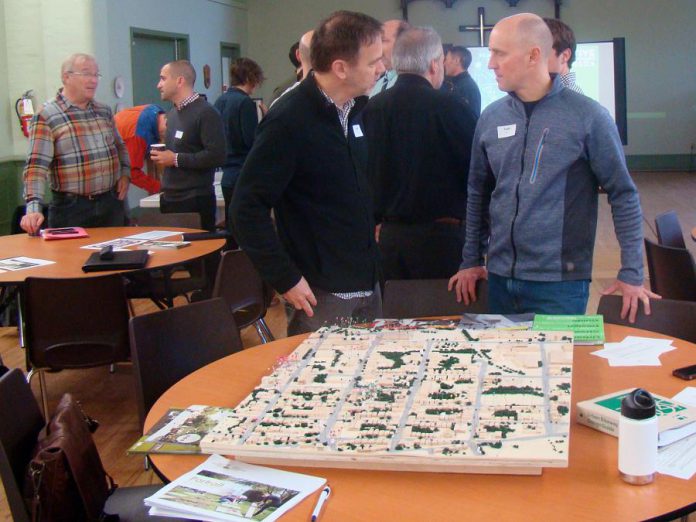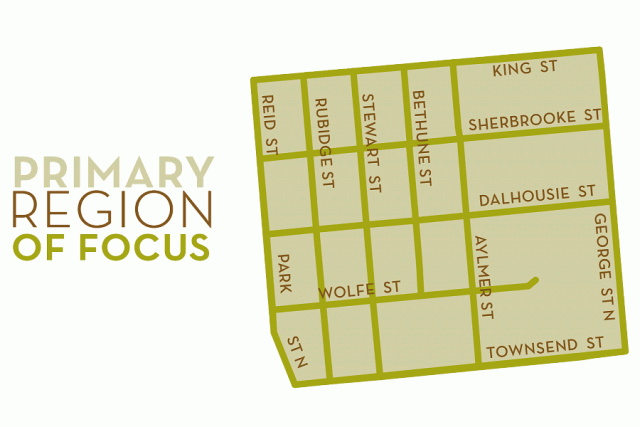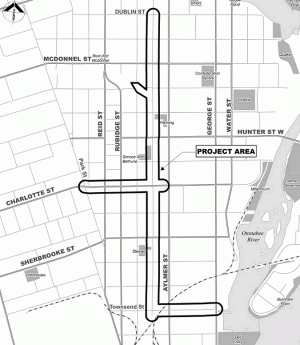
The design of our urban public spaces, streets, and sidewalks affects how we interact, travel, and recreate on a day-to-day basis.
Since May 2014, GreenUP has worked with a participatory urban planning project called Active Neighbourhoods Canada (ANC). In collaboration with diverse community partners, the ANC project has engaged residents of the Stewart Street area in reimagining public spaces, with the goal of creating a healthier and more sustainable neighbourhood.
The upcoming Bethune Street redevelopment project has been a key focus for the ANC project. The Bethune Street redevelopment is a part of the City of Peterborough’s Flood Reduction plan.
Starting in spring 2017, the Bethune Street roadway will be removed from curb-to-curb to accommodate an underground flood mitigation plan. This provides an opportunity for the streetscape to be rebuilt in a way that is innovative and supportive of diverse uses, such as walking, biking, socializing, playing, and traveling with assisted mobility devices.
In other words, the Bethune Street project is an excellent opportunity to showcase how urban design can contribute to a healthier and more sustainable community!
The City-led public consultations for the Bethune Street redevelopment begin on Thursday, May 19th, with two public consultations to gather feedback about the proposed preliminary designs. The consultations will take place from 3 to 5 p.m. and from 6 to 8:30 p.m. at the Holiday Inn (150 George St., Peterborough).
It is important to meaningfully involve citizens in urban planning and design processes, and to value the knowledge they bring to the table, because citizens hold unique knowledge of what works (and what doesn’t work) for their community.
Although the City-led consultation process is just beginning, the ANC project has already been talking to residents about their priorities for Bethune Street. With feedback from residents, and the support of a group of Masters of Planning students from Ryerson University, the ANC project has proposed a set of guiding principles for healthy and sustainable urban design.
These guiding principles include mobility and connectivity, accessibility, child-friendly design, greenscaping, placemaking, and a safe neighbourhood. We hope that these principles can help support people as they participate in public consultations, and we’ve outlined each of the principles below.

Bethune Street currently lacks infrastructure to support cyclists and pedestrians, but it is already a widely used active transportation route. Bethune Street connects with several major multi-use trails, so prioritizing diverse transportation modes will help create a more robust active transportation network.

Accessibility is a guiding principle because a healthy public space values all members of the community, and strives to ensure that everyone can access space equitably. Examples of accessible design include curb cuts, rest areas, legible signage, and well-paved sidewalks and paths.
Similarly, child-friendly design recognizes that children have specific safety needs, and also that children interact with public space in unique ways. Child-friendly design includes features like traffic calming, and offers opportunities for children to play and interact with public spaces in an age-appropriate manner by integrating natural play features, basket-ball courts, skate parks, and other elements that encourage active play.
A sustainable public realm also prioritizes greenscaping, or the inclusion of native vegetation, street trees, and natural features. Greenscaping has environmental benefits, including storm water management and cooling effects. It also has social and psychological benefits; public spaces with ample green spaces encourage people to travel actively, and make spaces livelier and more inviting.
Residents would also like to see principles of placemaking reflected in the Bethune Street design.
Placemaking refers to creating public spaces that highlight local culture and identity. This can be achieved through creative community art projects, signage, street furniture, historical markers, or other features that contribute to a unique place-based identity.
Lastly, residents would like to see safety prioritized in the new street design. Intersection design, lighting, sightlines, and clear delineation of space can contribute to safely, but perhaps most of all, the large numbers of people using the space to walk, bike, socialize, and play will contribute to building a safer street for all.
Urban design influences the health and sustainability of our communities. Car-centric urban design contributes to social isolation, increased risk of chronic disease, and negative environmental impacts. However, when social inclusion and active use of public spaces are prioritized in design plans, urban design can be an effective tool to build healthy and sustainable communities.
The City has been very receptive of including these guiding principles in the Bethune Street design process. The ANC project has been invited to share the guiding principles and showcase resident-informed visions for the streetscape during the Bethune Street public consultations.
Join us on May 19th to learn more, and to provide your input about how to make Bethune Street a healthy, sustainable, and vibrant public space.
For more information on the Active Neighbourhoods Canada project in Peterborough, visit activeneighbourhoods.tcat.ca.


























